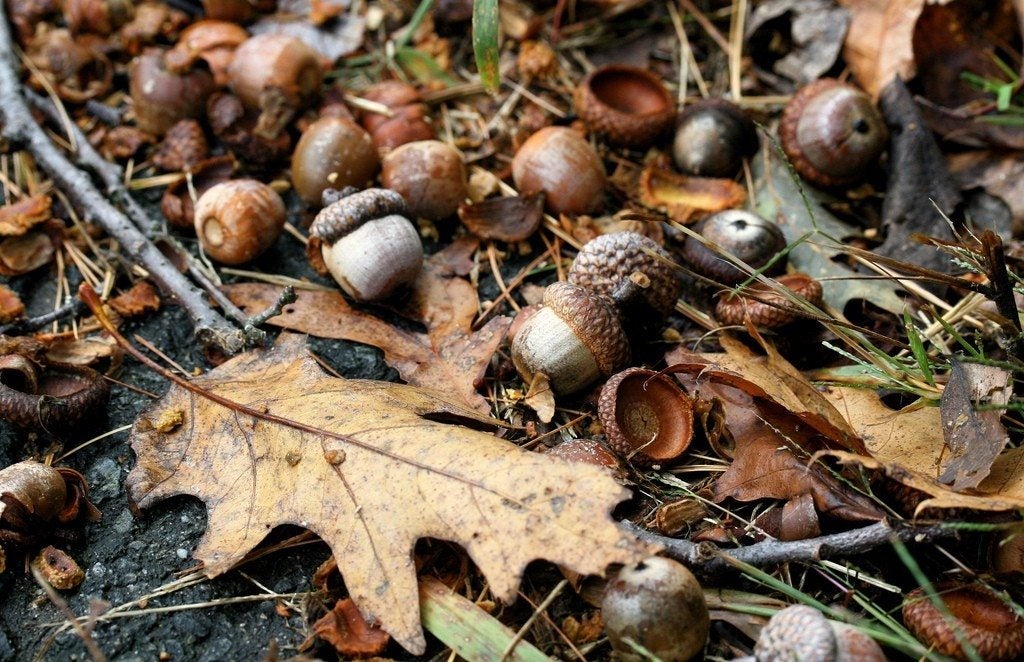Can You Compost Acorns: Tips On Composting Acorns

Oak trees will alternate between heavy and light years, but they'll drop acorns on your yard every fall. It's a treat for the squirrels which bury them with abandon, but it can be annoying to any homeowner with a landscaping plan. Acorns sprout easily and quickly, and within a month you'll see dozens of baby trees poking up from the grass, which must be pulled by hand. Getting rid of them is a priority, so you may be wondering if you can compost acorns. Not only do acorns compost, but they add an important ingredient, protein or brown compost layers, to the complete compost mix. The secret to successfully composting acorns is in the way you prepare them ahead of time.
Acorns in the Compost Pile
In order for compost ingredients to completely decay into usable compost, the pile must contain four things: green ingredients, brown ingredients, soil, and water. Green ingredients are those with more moisture, such as grass clippings or kitchen waste. The brown ingredients are drier types like branches, shredded paper, and, of course, acorns. Each ingredient adds different nutrients to the compost. When combined, they make an almost perfect soil conditioner and plant food. For a mix with a lot of green ingredients, a layer of acorns in the compost pile is an important addition, as maintaining a proper balance between browns and greens is vital.
How to Use Acorns as Compost
Using acorns as compost begins with breaking down the shells. The tough outer shell of the acorn takes years to break down naturally, but you can speed the process along. Gather all the acorns from your yard and spread them over the driveway. If you have a small amount, smash them with a hammer to crack them open and expose the meat inside. For larger, more normal acorn harvests, run them over with the car a few times until all the shells are cracked and the insides start to mash. Scrape the resulting mix from the driveway to add to the compost pile. Wait until you have a good layer of green ingredients on top of the pile, then add the mashed acorns on top. Spread them out to make an even layer, and add other dry ingredients, such as fallen leaves and shredded newspaper, to make a layer about 2 inches (5 cm.) deep. Cover this layer with about two inches (5 cm.) of soil and water the pile. Let it work for about a month, then turn the pile with a rake or shovel to allow air into the center of the heap, which will help the pile to heat up and decompose faster.
Gardening tips, videos, info and more delivered right to your inbox!
Sign up for the Gardening Know How newsletter today and receive a free copy of our e-book "How to Grow Delicious Tomatoes".
-
 Looking For Plants To Give You The Soft And Fuzzies? Try These 5 Fuzzy Leaf Plant Options
Looking For Plants To Give You The Soft And Fuzzies? Try These 5 Fuzzy Leaf Plant OptionsLovers of texture, drama, silver foliage and tactile plants will adore these special sensory garden additions. These fuzzy leaf plant options will leave you all aglow
By Susan Albert
-
 Get Ready For A Summer Of Hummers! Grow These Full Sun Hummingbird Plants and Flowers
Get Ready For A Summer Of Hummers! Grow These Full Sun Hummingbird Plants and FlowersIf you’re lucky enough to enjoy a sunny backyard, make sure you are maxing out on your pollinator opportunities and grow these full sun hummingbird plants and flowers
By Tonya Barnett